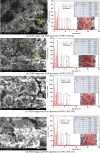Geopolymerization of fly ash and GGBS for sustainable industrial waste utilization
- PMID: 41038872
- PMCID: PMC12491643
- DOI: 10.1038/s41598-025-16574-5
Geopolymerization of fly ash and GGBS for sustainable industrial waste utilization
Abstract
This study aims to determine the feasibility of producing sustainable geopolymer bricks with industrial waste, such as fly ash and GGBS. The experimental investigations have been conducted at varying sodium hydroxide (NaOH) molarity (4 M, 6 M, 10 M, 12 M), GGBS incorporation levels (0%, 5%, 10%, 15%, 20%), curing temperatures (ambient, 60 °C, 80 °C, 120 °C), and curing durations (7, 14, and 28 days) to examine physical and mechanical properties of geopolymer bricks. The findings demonstrated a notable increase in compressive strength with elevated GGBS content, with a peak strength of 49.63 MPa at 20% GGBS, 10 M NaOH molarity, and a curing temperature of 80 °C after 28 days. Elevated curing temperatures improve the compressive strength, and attain its maximum value at 120 °C; however, 80 °C was identified as the optimal setting for balancing mechanical performance and energy efficiency. Moreover, the augmented quantity of GGBS enhanced bulk density and durability while reducing porosity and water absorption. In optimal conditions, microstructural analyses employing energy dispersive X-ray spectroscopy (EDX) and scanning electron microscopy (SEM) revealed enhanced geopolymer gel development and a more compact matrix formation. Comparative analysis of SEM pictures and EDS data indicates that the high concentration of Ca and Si contributes to the dense microstructure and abundant C-S-H area. Geopolymer bricks exhibit enhanced strength owing to their significant C-S-H composition. The study concludes that the integration of industrial waste ashes, specifically with 10 M NaOH, 20% GGBS, and curing at 80 °C, yields high strength geopolymer bricks with enhanced microstructural properties, suggesting their viability as an environmentally sustainable substitute for conventional construction materials.
Keywords: Bulk density; Compressive strength; EDX; Fly ash; GGBS; Geopolymer; SEM; Water absorption.
© 2025. The Author(s).
Conflict of interest statement
Declarations. Competing interests: The authors declare no competing interests. Ethical approval: Not applicable.
Figures










References
-
- Gencel, O. et al. Properties of bricks with waste ferrochromium slag and zeolite. J. Clean. Prod.59, 111–119. 10.1016/j.jclepro.2013.06.055 (2013).
-
- Das, D., Gołąbiewska, A. & Rout, P. K. Geopolymer bricks: the next generation of construction materials for sustainable environment. Constr. Build. Mater.445, 137876. 10.1016/j.conbuildmat.2024.137876 (2024).
-
- Shubbar, A. A., Sadique, M., Kot, P. & Atherton, W. Future of clay-based construction materials – A review. Constr. Build. Mater.210, 172–187. 10.1016/j.conbuildmat.2019.03.206 (2019).
-
- Morchhale, K., Ramakrishnan, N. & Dindorkar, N. Bulk. Utilisation of copper mine tailings in production of bricks. J. Institution Eng. (India) Part. CV Civil Eng. Div.87, 13–16 (2006).
-
- Roy, S., Adhikari, G. R. & Gupta, R. N. Use of gold mill tailings in making bricks: a feasibility study. Waste Manage. Res. J. Sustainable Circular Econ.25, 475–482. 10.1177/0734242X07076944 (2007). - PubMed
LinkOut - more resources
Full Text Sources
Research Materials
Miscellaneous

